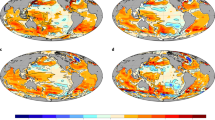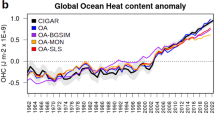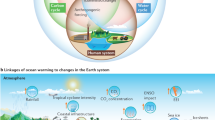Abstract
The World Ocean is rapidly changing, with global and regional modification of temperature and salinity, resulting in widespread and irreversible impacts. While the most pronounced observed temperature and salinity changes are located in the upper ocean, changes in water masses at depth have been identified and will probably strengthen in the future. Here, using 11 climate models, we define when anthropogenic temperature and salinity changes are expected to emerge from natural variability in the ocean interior along density surfaces. The models predict that in 2020, 20–55% of the Atlantic, Pacific and Indian basins have an emergent anthropogenic signal; reaching 40–65% in 2050 and 55–80% in 2080. The well-ventilated Southern Ocean water masses emerge very rapidly, as early as the 1980–1990s, while the Northern Hemisphere water masses emerge in the 2010–2030s. Our results highlight the importance of maintaining and augmenting an ocean observing system capable of detecting and monitoring persistent anthropogenic changes.
This is a preview of subscription content, access via your institution
Access options
Access Nature and 54 other Nature Portfolio journals
Get Nature+, our best-value online-access subscription
$29.99 / 30 days
cancel any time
Subscribe to this journal
Receive 12 print issues and online access
$209.00 per year
only $17.42 per issue
Buy this article
- Purchase on Springer Link
- Instant access to full article PDF
Prices may be subject to local taxes which are calculated during checkout




Similar content being viewed by others
Data availability
All CMIP5 model data used in this paper are available through the Earth System Grid and freely available for download (https://esgf-node.llnl.gov/search/cmip5/).
Code availability
The analysis code for this paper is written in Python and is available on GitHub (https://github.com/ysilvy/ocean_toe_2020)54. The density binning code and data are available upon request to the authors.
Change history
28 August 2020
In the PDF version of this Article originally published online, Figs. 3 and 4 appeared in reverse order; this has now been amended. The HTML version was unaffected.
References
Barnett, T. P., Pierce, D. W. & Schnur, R. Detection of anthropogenic climate change in the world’s oceans. Science 292, 270–274 (2001).
Reichert, B. K., Schnur, R. & Bengtsson, L. Global ocean warming tied to anthropogenic forcing. Geophys. Res. Lett. 29, 20–4 (2002).
Barnett, T. P. et al. Penetration of human-induced warming into the world’s oceans. Science 309, 284–287 (2005).
Palmer, M. D., Good, S. A., Haines, K., Rayner, N. A. & Stott, P. A. A new perspective on warming of the global oceans. Geophys. Res. Lett. 36, L20709 (2009).
Pierce, D. W., Gleckler, P. J., Barnett, T. P., Santer, B. D. & Durack, P. J. The fingerprint of human-induced changes in the ocean’s salinity and temperature fields. Geophys. Res. Lett. 39, L21704 (2012).
Gleckler, P. J. et al. Human-induced global ocean warming on multidecadal timescales. Nat. Clim. Change 2, 524–529 (2012).
Tokarska, K. B., Hegerl, G. C., Schurer, A. P., Ribes, A. & Fasullo, J. T. Quantifying human contributions to past and future ocean warming and thermosteric sea level rise. Environ. Res. Lett. 14, 074020 (2019).
Bilbao, R. A. F., Gregory, J. M., Bouttes, N., Palmer, M. D. & Stott, P. Attribution of ocean temperature change to anthropogenic and natural forcings using the temporal, vertical and geographical structure. Clim. Dynam. 53, 5389–5413 (2019).
Terray, L. et al. Near-surface salinity as nature’s rain gauge to detect human influence on the tropical water cycle. J. Clim. 25, 958–977 (2012).
Stott, P. A., Sutton, R. T. & Smith, D. M. Detection and attribution of Atlantic salinity changes. Geophys. Res. Lett. 35, L21702 (2008).
Swart, N. C., Gille, S. T., Fyfe, J. C. & Gillett, N. P. Recent Southern Ocean warming and freshening driven by greenhouse gas emissions and ozone depletion. Nat. Geosci. 11, 836–841 (2018).
Mahlstein, I., Knutti, R., Solomon, S. & Portmann, R. W. Early onset of significant local warming in low latitude countries. Environ. Res. Lett. 6, 034009 (2011).
Diffenbaugh, N. S. & Scherer, M. Observational and model evidence of global emergence of permanent, unprecedented heat in the 20th and 21st centuries. Climatic Change 107, 615–624 (2011).
Hawkins, E. & Sutton, R. Time of emergence of climate signals. Geophys. Res. Lett. 39, L01702 (2012).
Mora, C. et al. The projected timing of climate departure from recent variability. Nature 502, 183–187 (2013).
Diffenbaugh, N. S. & Charland, A. Probability of emergence of novel temperature regimes at different levels of cumulative carbon emissions. Front. Ecol. Environ. 14, 418–423 (2016).
Lehner, F., Deser, C. & Terray, L. Toward a new estimate of ‘Time of Emergence’ of anthropogenic warming: insights from dynamical adjustment and a large initial-condition model ensemble. J. Clim. 30, 7739–7756 (2017).
Giorgi, F. & Bi, X. Time of emergence (TOE) of GHG-forced precipitation change hot-spots. Geophys. Res. Lett. 36, L06709 (2009).
Mahlstein, I., Portmann, R. W., Daniel, J. S., Solomon, S. & Knutti, R. Perceptible changes in regional precipitation in a future climate. Geophys. Res. Lett. 39, L05701 (2012).
Lyu, K., Zhang, X., Church, J. A., Slangen, A. B. A. & Hu, J. Time of emergence for regional sea-level change. Nat. Clim. Change 4, 1006–1010 (2014).
Keller, K. M., Joos, F. & Raible, C. C. Time of emergence of trends in ocean biogeochemistry. Biogeosciences 11, 3647–3659 (2014).
Rodgers, K. B., Lin, J. & Frölicher, T. L. Emergence of multiple ocean ecosystem drivers in a large ensemble suite with an Earth system model. Biogeosciences 12, 3301–3320 (2015).
Frölicher, T. L., Rodgers, K. B., Stock, C. A. & Cheung, W. W. L. Sources of uncertainties in 21st century projections of potential ocean ecosystem stressors. Glob. Biogeochem. Cycles 30, 1224–1243 (2016).
Henson, S. A. et al. Rapid emergence of climate change in environmental drivers of marine ecosystems. Nat. Commun. 8, 14682 (2017).
Turk, D. et al. Time of emergence of surface ocean carbon dioxide trends in the North American coastal margins in support of ocean acidification observing system design. Front. Mar. Sci. 6, 91 (2019).
Schlunegger, S. et al. Emergence of anthropogenic signals in the ocean carbon cycle. Nat. Clim. Change 9, 719–725 (2019).
Banks, H. & Wood, R. Where to look for anthropogenic climate change in the ocean. J. Clim. 15, 879–891 (2002).
Helm, K. P., Bindoff, N. L. & Church, J. A. Changes in the global hydrological-cycle inferred from ocean salinity. Geophys. Res. Lett. 37, L18701 (2010).
Durack, P. J. & Wijffels, S. E. Fifty-year trends in global ocean salinities and their relationship to broad-scale warming. J. Clim. 23, 4342–4362 (2010).
Durack, P. J., Wijffels, S. E. & Matear, R. J. Ocean salinities reveal strong global water cycle intensification during 1950 to 2000. Science 336, 455–458 (2012).
Lago, V. et al. Simulating the role of surface forcing on observed multidecadal upper-ocean salinity changes. J. Clim. 29, 5575–5588 (2016).
Zika, J. D. et al. Improved estimates of water cycle change from ocean salinity: the key role of ocean warming. Environ. Res. Lett. 13, 074036 (2018).
Sallee, J.-B. et al. Assessment of Southern Ocean water mass circulation and characteristics in CMIP5 models: historical bias and forcing response. J. Geophys. Res. Oceans 118, 1830–1844 (2013).
Heuzé, C. North Atlantic deep water formation and AMOC in CMIP5 models. Ocean Sci. 13, 609–622 (2017).
Good, S. A., Martin, M. J. & Rayner, N. A. EN4: quality controlled ocean temperature and salinity profiles and monthly objective analyses with uncertainty estimates. J. Geophys. Res. Oceans 118, 6704–6716 (2013).
Sallée, J.-B., Speer, K., Rintoul, S. & Wijffels, S. Southern Ocean thermocline ventilation. J. Phys. Oceanogr. 40, 509–529 (2010).
de Lavergne, C., Palter, J. B., Galbraith, E. D., Bernardello, R. & Marinov, I. Cessation of deep convection in the open Southern Ocean under anthropogenic climate change. Nat. Clim. Change 4, 278–282 (2014).
Heuzé, C., Ridley, J. K., Calvert, D., Stevens, D. P. & Heywood, K. J. Increasing vertical mixing to reduce Southern Ocean deep convection in NEMO3.4. Geosci. Model Dev. 8, 3119–3130 (2015).
Dufour, C. O. et al. Preconditioning of the Weddell Sea polynya by the ocean mesoscale and dense water overflows. J. Clim. 30, 7719–7737 (2017).
IPCC Special Report on Global Warming of 1.5 °C (eds Masson-Delmotte, V. et al.) (WMO, 2018).
Yamaguchi, R. & Suga, T. Trend and variability in global upper‐ocean stratification since the 1960s. J. Geophys. Res. Oceans 124, 8933–8948 (2019).
Gregory, J. M. et al. The flux-anomaly-forced model intercomparison project (FAFMIP) contribution to CMIP6: investigation of sea-level and ocean climate change in response to CO2 forcing. Geosci. Model Dev. 9, 3993–4017 (2016).
Todd, A. et al. Ocean-only FAFMIP: understanding regional patterns of ocean heat content and dynamic sea level change. J. Adv. Model Earth. Syst. https://doi.org/10.1002/essoar.10501557.1 (2020).
Gille, S. T. Decadal-scale temperature trends in the southern hemisphere ocean. J. Clim. 21, 4749–4765 (2008).
Khatiwala, S. P. et al. Global ocean storage of anthropogenic carbon. Biogeosciences 10, 2169–2191 (2013).
Frölicher, T. L. et al. Dominance of the Southern Ocean in anthropogenic carbon and heat uptake in CMIP5 models. J. Clim. 28, 862–886 (2015).
Roemmich, D. et al. Unabated planetary warming and its ocean structure since 2006. Nat. Clim. Change 5, 240–245 (2015).
Durack, P. J., Gleckler, P. J., Landerer, F. W. & Taylor, K. E. Quantifying underestimates of long-term upper-ocean warming. Nat. Clim. Change 4, 999–1005 (2014).
McDougall, T. J. & Jackett, D. R. The material derivative of neutral density. J. Mar. Res. 63, 159–185 (2005).
Häkkinen, S., Rhines, P. B. & Worthen, D. L. Warming of the global ocean: spatial structure and water-mass trends. J. Clim. 29, 4949–4963 (2016).
Desbruyères, D., McDonagh, E. L., King, B. A. & Thierry, V. Global and full-depth ocean temperature trends during the early twenty-first century from argo and repeat hydrography. J. Clim. 30, 1985–1997 (2017).
Iudicone, D. et al. Water masses as a unifying framework for understanding the Southern Ocean carbon cycle. Biogeosciences 8, 1031–1052 (2011).
Hawkins, E. et al. Uncertainties in the timing of unprecedented climates. Nature 511, E3–E5 (2014).
Silvy, Y. ocean_toe_2020 v1.0.0. Github repository (2020); https://doi.org/10.5281/zenodo.3944613
Acknowledgements
We thank C. de Lavergne, A. Fedorov, P. Gleckler, J. Gregory, E. Hawkins, G. Madec, H. Mercier, J. Mignot, B. Santer and L. Terray for helpful discussions. We acknowledge the support from the Make Our Planet Great Again project ARCHANGE (Agence Nationale pour la Recherche project no. ANR-18-MPGA-0001) from the European Research Council under the European Union’s Horizon 2020 research and innovation programme (grant no. 637770) and from the Centre National de la Recherche Scientifique. We also acknowledge the CMIP5 modelling groups, the ESGF and IPSL/ESPRI-MOD data distribution systems. The work of P.J.D. was prepared by Lawrence Livermore National Laboratory (LLNL) under contract no. DE-AC52-07NA27344 and is a contribution to the US Department of Energy, Office of Science, Climate and Environmental Sciences Division, Regional and Global Modeling and Analysis Program (LLNL release no. LLNL-JRNL-794900).
Author information
Authors and Affiliations
Contributions
The density binning of CMIP5 data was designed and performed by E.G. and P.J.D. All subsequent analysis for this paper was performed by Y.S. and supervised by E.G and J.-B.S. Observational data were provided by P.J.D. All authors contributed to interpreting the results and writing the manuscript.
Corresponding author
Ethics declarations
Competing interests
The authors declare no competing interests.
Additional information
Peer review information Nature Climate Change thanks Veronique Lago, Nadya Vinogradova-Shiffer and the other, anonymous, reviewer(s) for their contribution to the peer review of this work.
Publisher’s note Springer Nature remains neutral with regard to jurisdictional claims in published maps and institutional affiliations.
Supplementary information
Supplementary Information
Supplementary discussion, Figs. 1–14 and Table 1.
Rights and permissions
About this article
Cite this article
Silvy, Y., Guilyardi, E., Sallée, JB. et al. Human-induced changes to the global ocean water masses and their time of emergence. Nat. Clim. Chang. 10, 1030–1036 (2020). https://doi.org/10.1038/s41558-020-0878-x
Received:
Accepted:
Published:
Issue Date:
DOI: https://doi.org/10.1038/s41558-020-0878-x
This article is cited by
-
Novel PANI:Borophene/Si Schottky device for the sensitive detection of illumination and NaCl salt solutions
Journal of Materials Science: Materials in Electronics (2024)
-
Water masses in the Caribbean Sea and sub-annual variability in the Guajira upwelling region
Ocean Dynamics (2023)
-
Coastal ecological impacts from pumice rafts
Scientific Reports (2022)
-
Past and future ocean warming
Nature Reviews Earth & Environment (2022)
-
Observed poleward freshwater transport since 1970
Nature (2022)



